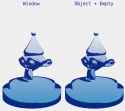>>1016161
> is the entire process simply a matter of shaders?
As mentioned before you can use either shaders, image textures/texture paint, the compositor or a mix of them to achieve this effect. Personally, I would prefer using shaders only, because its more flexible, requires fewer steps and makes data handling much easier.
In the example video you posted, I can't see if the gradient is following the camera, because the movement is very subtle. In my video I have made a comparison, if you intend to use a similar shader setup as the one i posted as an example previously.
- On the left, the gradient is bound to the camera/window. That means when the camera moves, rotates etc. the gradient on your 3D model will change and follow the camera too (notice, how Suzanne becomes more white as it approaches the top of the screen). If its desired as an artistic effect - great. If not, see example on right:
- On the right the gradient is bound to an empty that is also parented to Suzanne. This way, the gradient stays consistent no matter the position or other transformations of Suzanne or the camera.
(The difference is very subtle in my example. I should have made the contrast a bit higher to make the difference better visisble. :( )
>Is this good enough?
>https://www.youtube.com/watch?v=PLB18SppEdM
Well, I am not sure how experienced you are with Blender. But judging by your model, which looks very nice already, you seem to know how to operate Blender. The tutorial you posted seems very basic, but if you are not very familiar with shaders at all, it's good for a start.
